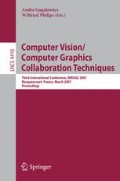Abstract
This paper introduces a new concept within shadow segmentation for usage in shadow removal and augmentation through construction of an alpha overlay shadow model. Previously, an image was considered to consist of shadow and non-shadow regions. We construct a model that accounts for sunlit, umbra and penumbra regions. The model is based on theories about color constancy, daylight, and the geometry that causes penumbra. The behavior of the model is analyzed and a graph cut energy minimization is applied to estimate the alpha parameter. The approach is demonstrated on natural complex image situations. The results are convincing, but the alpha gradient in penumbra must be improved.
Access this chapter
Tax calculation will be finalised at checkout
Purchases are for personal use only
Preview
Unable to display preview. Download preview PDF.
References
Salvador, E., Cavallaro, A., Ebrahimi, T.: Shadow identification and classification using invariant color models. In: Proc. of IEEE Signal Processing Society International Conference on Acoustics, Speech, and Signal Processing (ICASSP-2001), Salt Lake City, Utah, USA, 7-11 May, 2001, pp. 1545–1548. IEEE Computer Society Press, Los Alamitos (2001)
Salvador, E., Cavallaro, A., Ebrahimi, T.: Cast shadow segmentation using invariant color features. Comput. Vis. Image Underst. 95(2), 238–259 (2004), doi:10.1016/j.cviu.2004.03.008
Madsen, C.B.: Using real shadows to create virtual ones. In: Bigun, J., Gustavsson, T. (eds.) SCIA 2003. LNCS, vol. 2749, pp. 820–827. Springer, Heidelberg (2003)
Finlayson, G.D., Hordley, S.D., Drew, M.S.: Removing shadows from images. In: Heyden, A., et al. (eds.) ECCV 2002. LNCS, vol. 2353, pp. 823–836. Springer, Heidelberg (2002)
Finlayson, G.D., Hordley, S.D., Drew, M.S.: Removing shadows from images using retinex. In: Color Imaging Conference, IS&T - The Society for Imaging Science and Technology, pp. 73–79 (2002)
Lu, C., Drew, M.S.: Shadow segmentation and shadow-free chromaticity via markov random fields. In: IS&T/SID 13th Color Imaging Conference, Scottsdale, AZ (2005)
Barnard, K., Funt, B.: Experiments in sensor sharpening for color constancy. In: IS&T/SID Sixth Color Imaging Conference: Color Science, Systems and Applications, Scottsdale, Arizona, November 1998, pp. 43–46 (1998)
Wang, J., Cohen, M.F.: An iterative optimization approach for unified image segmentation and matting. In: ICCV, pp. 936–943. IEEE Computer Society Press, Los Alamitos (2005)
Kolmogorov, V., Zabih, R.: What energy functions can be minimized via graph cuts? IEEE Trans. Pattern Anal. Mach. Intell. 26(2), 147–159 (2004)
Author information
Authors and Affiliations
Editor information
Rights and permissions
Copyright information
© 2007 Springer Berlin Heidelberg
About this paper
Cite this paper
Nielsen, M., Madsen, C.B. (2007). Segmentation of Soft Shadows Based on a Daylight- and Penumbra Model. In: Gagalowicz, A., Philips, W. (eds) Computer Vision/Computer Graphics Collaboration Techniques. MIRAGE 2007. Lecture Notes in Computer Science, vol 4418. Springer, Berlin, Heidelberg. https://doi.org/10.1007/978-3-540-71457-6_31
Download citation
DOI: https://doi.org/10.1007/978-3-540-71457-6_31
Publisher Name: Springer, Berlin, Heidelberg
Print ISBN: 978-3-540-71456-9
Online ISBN: 978-3-540-71457-6
eBook Packages: Computer ScienceComputer Science (R0)

